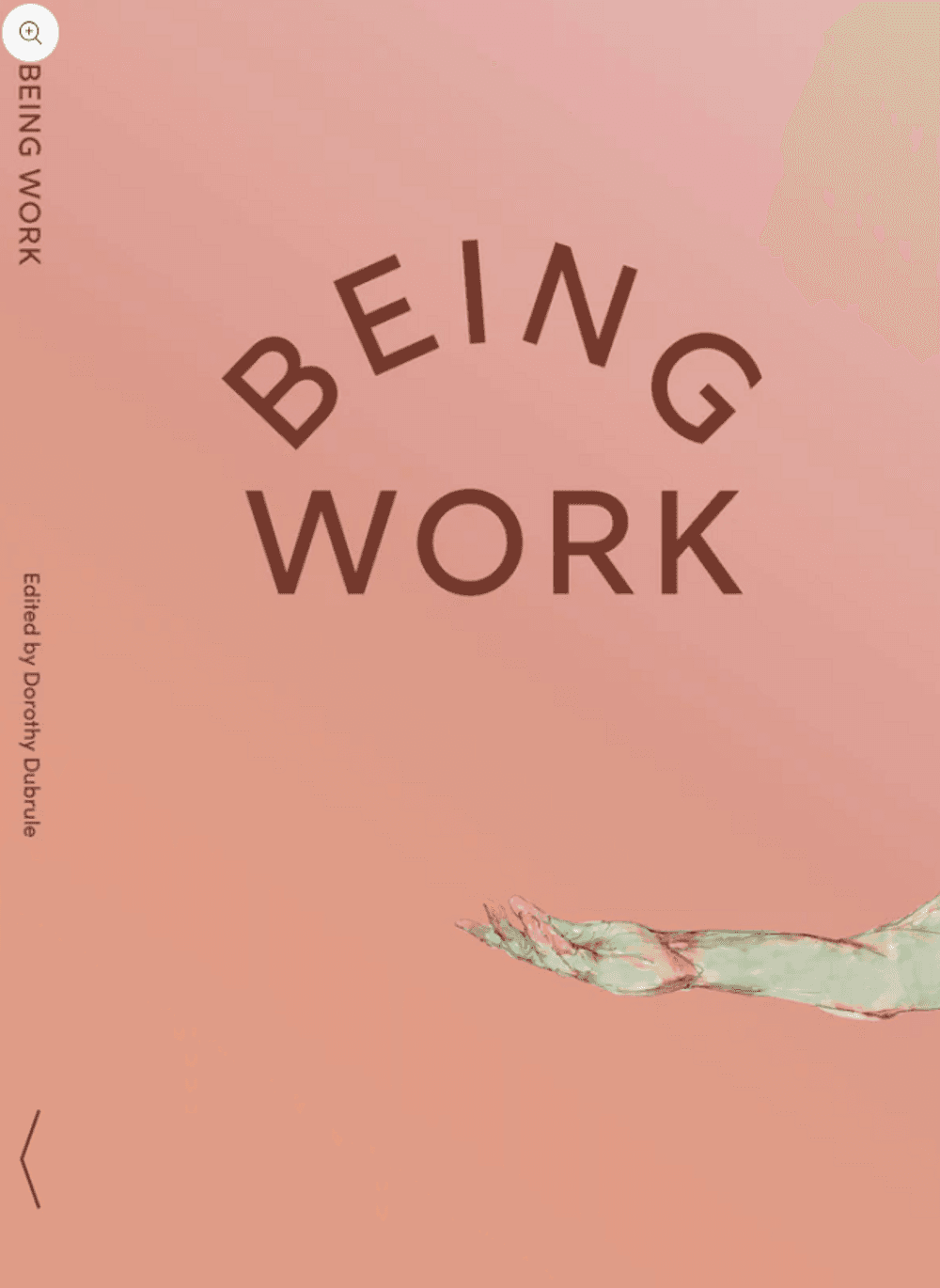Stay in the Loop
BSR publishes on a weekly schedule, with an email newsletter every Wednesday and Thursday morning. There’s no paywall, and subscribing is always free.
An intriguing look at performance artists in art galleries
Being Work, edited by Dorothy Dubrule

You’ve likely encountered them in a museum: static or moving bodies who are part of a contemporary artwork. More and more, artists worldwide are creating conceptual or performance art, a liminal intersection of sculpture and movement. Being Work is a slim, eminently readable volume that dives into the world of the performers who make live work in a visual arts context. Inspired by conversations with colleagues, editor Dorothy Dubrule crafted this look at a small but vibrant slice of the creative economy.
Dubrule herself has been “the work,” and she opens with a thoughtful overview of how this relatively unexplored, often mysterious arena functions. Her impetus was curiosity about “what the value of this strange kind of labor was, to my fellow performers and to the throngs of gallery visitors.” Performers are often dancers and actors (Dubrule studied ballet) who can withstand the physical demands of either constant movement or total stasis. Oxymoronically, they are highly visible yet completely nullified, subsumed into an artist’s vision and transformed into objects.
Day work, shift work, work that witnesses
Members of this loosely connected community undertake projects for various reasons, sometimes simply for the income. Some jobs are day work, some longer-term. Some installations happen only once, but other times work will be re-mounted, and performers may be re-engaged.
Like many artworks, these installations may require nudity, subject to contractual parameters and requiring personal protections. Cell phone use or photography in a gallery can be intrusive or even problematic. One performer was advised to “make friends with museum security guards. ... [They] are there for you when people overstep the boundaries.”
Larger or longer-term installations of prominent artists may entail shift work, with highly structured time on and time off, while more amorphous situations can be distressing. Sometimes performers are thrust into environments and left relatively stranded, but other times the artist-creators are helpful and present. Most require participants to attend rehearsals, testing structures to which they might be (uncomfortably) strapped or in which they might be confined. And due to the high-stakes world in which these major conceptual artists work, some require that performers sign non-disclosure agreements.
Dubrule notes that “unlike stationary art objects that wait, passively, to be witnessed, live works witness you back,” setting up a complex, unusual relationship. While viewing a painting is an anonymous act, a live person (one who is the art) creates a dynamic and potentially uncomfortable situation for both parties. Performers may be alone in a gallery, and since sound travels easily in museums, installation participants can often hear visitor comments.
Working with Marina Abramović and Maria Hassabi
After her revelatory essay, Dubrule focuses most of the book on eight performers (including herself). Candid narratives from interdisciplinary artist, writer, director, and performer Mireya Lucio and movement artist, writer, and choreographer Casey Brown are highlights.
In 2011, Lucio, fresh with an MFA in theater from CalArts, auditioned for a Los Angeles Museum of Contemporary Art gala performance by Marina Abramović, a performance art luminary. Lucio was one of 100 people at the first rehearsal, where a participant lodged a protest about wages and working conditions. Part of this controversial artist’s installation required performers to spend three hours under dining tables with their heads protruding through the tables while patrons ate, while others lay on tables covered with faux skeletons. In diary style, Lucio documents the evening’s slow progression and the physical and emotional toll of this challenging piece.
Brown writes about her participation in Maria Hassabi’s carefully calibrated 2015 work, PLASTIC, at the Hammer Museum in Los Angeles, a slow-motion sustained-movement performance piece with grey-clad dancers in various configurations throughout the museum. Brown was required to shift slowly among 30 poses lasting 30 seconds to two minutes each. Unlike Lucio’s gig for Abramović—which was just for one night and required anonymity—this monthlong museum performance piece was highly structured and monitored by the artist. PLASTIC is a work listed on Hassabi’s website, and the performers (including Brown) are fully credited.
A tantalizing look
Some contributing essayists cite the installations in which they appeared, but in Dubrule’s desire to focus on these often-unknown participants, there are no statements from or about the artists. Their conceptual work has been amply publicized, but I found myself wishing to have these artworks referenced or described. The book’s abstracted watercolor illustrations, while worthy and appealing, don’t add any specifics to a book that explores such unfamiliar terrain. But I still found Being Work a tantalizing and pragmatic look into an unfamiliar part of the art world.
What, When, Where
Being Work. Edited by Dorothy Dubrule; illustrations by Eileen Wolf Echikson. Los Angeles: Insert Press, 2024. 109 pages, paperback; $40. Get it here.
Performers/essayists and artworks: Mireya Lucio (work for Marina Abramović); Casey Brown (for Maria Hassabi, PLASTIC); Jessica Emmanuel (for Xu Zhen); Kestrel Farin Leah (for Julien Prévieux, What Shall We Do Next?); Allie Hankins (for Gordon Hall, THROUGH and THROUGH and THROUGH); effie bowen (for Narcissister); Paul Hamilton (for Bruce Nauman, Wall-Floor Positions); and Dorothy Dubrule (for Tino Sehgal, Selling Out).
Sign up for our newsletter
All of the week's new articles, all in one place. Sign up for the free weekly BSR newsletters, and don't miss a conversation.
 Gail Obenreder
Gail Obenreder